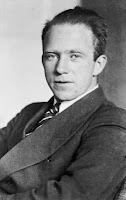In 1927, Werner Heisneberg published the Uncertainty Principle. As a mathematical formula, is looks like this:
Δx⋅Δp≥(h/4π)
In simplest terms, the principle states
that the "uncertainty in the measurement of position times the uncertainty in the measurement of momentum is always greater than or equal to a very small number."Okay, that wasn’t simple. So, let’s pull apart the ideas
Uncertainty in measurement
Any time you make a measurement there is some inherent uncertainty. Let’s imagine that you want to measure the length of a pencil mark on your paper. You lay down a ruler and measure the mark to be 4.3 cm. If you picked up the ruler and measured it again, assuming that you were careful, you would get the same value. But, if I then handed you a ruler marked to the hundredth of cm (and a magnifying glass) you might get 4.28 cm or 4.31 cm. If you picked the ruler up and laid it back down, you would be less likely to get exactly the same measurement. If I found a ruler that measured to the thousandths of a cm, you would have an even harder time consistently getting exactly the same value. The line isn’t changing. This is just proof that your measurement is not perfect. The imperfection (the changeable amount) in your measurement is the uncertainty.
Recognizing that, your second measurement might be recorded as 4.30 +/- 0.02 cm.
Multiplying uncertainties
Heisenberg’s Principle looks at the product of two uncertainties (position and momentum). When a product of two values is equal to a constant, they have an indirect relationship (as one goes up, the other goes down. (In other words, if x⋅y =10, as y gets smaller, x has to get bigger for the math to still work.)
In this case, as the uncertainty of the position goes down, the uncertainty of the momentum goes up. In English - the more precisely we know the momentum of something, the less precisely we can know it’s location.
A very small number
The very small number mentioned above is approximately 5.3x10-35 (which is Planck’s constant divided by 4π). This means that the Uncertainty Principle doesn’t matter for large things like planets, or people, or ants or even bacteria and viruses. It does matter however for electrons.
Why we (chemists) care
Because Heisenberg says (correctly) that we can’t know exactly where an electron is and how it is moving, it becomes logical, and even required to discuss and calculate the probability of an electron’s location and behavior, rather than trying to be specific.
Historical Figures are Never Easy
Werner Heisenberg is a complicated figure. Early in his career he studied with Neils Bohr in Copenhagen and the cooperative work they did led to some of Bohr's best work and to Heisenberg’s most famous work, the Uncertainty Principle. However, Heisenberg was a German, and ended up leading the Nazi attempt to develop a nuclear bomb. After the war, Heisenberg was captured, held and questioned by the British. During that time, he claimed that he had sabotaged the Nazi bomb effort from within, to ensure that Hitler never gained access to such a weapon. Others have said that there is no evidence of his subterfuge and that he simply was unable to accomplish the task. At this point, the truth may never be known.



No comments:
Post a Comment